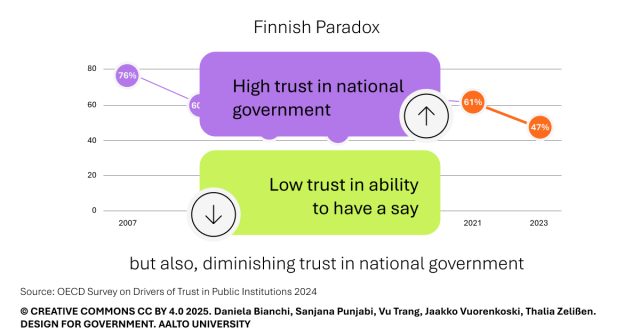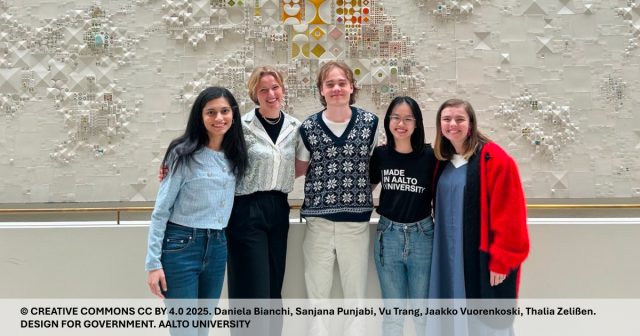This blog post reports on work-in-progress within the DfG course! The post is written by group 1 dealing with the Ministry of Finance’s brief on ‘Open Governance’. The group includes Daniela Bianchi from Collaborative and Industrial Design program (Aalto ARTS), Sanjana Punjabi from Collaborative and Industrial Design program (Aalto ARTS), Vu Trang from the Sustainable Entrepreneurship program (Aalto BIZ), Thalia Zelißen from the Environmental Engineering Program (TU Munich) and Jaakko Vuorenkoski from Information and Service Management program (Aalto BIZ).
Written by: Daniela Bianchi
Hi there! This is the end of our journey exploring proposals for ‘Open Government for an Age-Friendly Finland’, our initial brief. Thanks for joining us on this ever-changing adventure.
Previously, we wrote about our experience with, first, understanding everything related to Open Government Finland on a theoretical level, then proceeding with interviews and fieldwork that further expanded on what this actually means in practice. Once we had a better grasp of all the information – or as much as possible within our timeframe – we analysed all the data and articulated the main findings. As discussed in our last blog, these findings weighed heavily on the operational model of Open Government Finland, and how this has affected – or not – its impact and reach within the different levels of society.
As you can read on these earlier posts, our group has explored a myriad of alternatives. First, we proposed an initial concept where Open Government could be an ‘orchestrator’, then we moved to the idea that it is an ‘open concept’, and now, an active organisation within government. The objective behind this concept is that it advocates its main principles at policy level, in an effort to build democratic resilience and have an overarching impact from policy to society.

Figure 1. Finland faces a particular challenge; even though they’ve been frontrunners in trust in national government, their citizens have a low trust in their ability to have a say in decision-making. This trend, if continued, runs the risk of developing into a trust issue in the upcoming years. Open Government principles are key to addressing this issue.
This latest version of our vision for Open Government tackles the main issues uncovered during our process, and can be summarized in two concrete opportunities that we hope can guide Open Government Finland in the future:
Open Government works as a direct link between policy makers and society
As aforementioned, the Ministry of Finance has already done wonderful work building an extensive network at the civil society level – a strategic alliance that allows better reach towards society and the inclusion of all voices. Now though, it’s time to shift this focus and build a strong network at the policy level too, which can be achieved by:
- Sharing all knowledge already created at Open Government and feed this into policy level. For instance, reports such as those developed from National Dialogue Reports, feedback from council days, or information gathered from the Open Democracy Network, are all very valuable materials that can provide insights at policy level, which in turn allows for better and a more bottom-up policy approach (Blomkamp, 2018).
- Expanding the current actions that Open Government already has into tools that can include both policy and society, this would mean going beyond activities such as Civil Society Academy Day or the various council days, elaborating new activities that could bring these two actors closer together. A good example of this is Paris citizens’ assembly, an Open Government action where 100 randomly selected participants get together and discuss policymaking, submitting recommendations to the Parisian government and council (Open Government Partnership: Paris Action Plan 2024-2026, 2024).
Open Government advocates its principles at the policy level
To tackle issues such as declining trust and democracy, Open Government needs to have its rightful place within democracy. By this, we mean that Open Government cannot be an initiative with small resources – however motivated and amazing the team behind it can be – and it requires serious consideration at policy level. As such, the OECD has given the recommendation that “Open government needs to be supported by relevant legislation, guidelines and guidance” (OECD, 2023). This strategy can be achieved by:
- Aligning agendas between Open Government and policy level actors, which would support decision-making whilst also allowing people in Finland to participate in politically relevant agenda discussions.
- Open Government should have a permanent space for discussion within a selected parliamentary committee, which would allow for its principles and actions to be considered at policy level with a neutral but relevant perspective.
- Reports and materials generated by Open Government should be strengthened with policy proposals that can be shared within the political spectrum.
Balancing a broad vision with practical impact
These two actions – which might seem simple enough – were actually very hard for us to develop. One of the things we had to constantly fight against was the impulse to ‘fix’ and propose concrete solutions, something that we DFG students know as ‘downstream level’. Instead, our proposal needed to stay at an ‘upstream’ or policy level, which was a new experience for us all within the group, and a bit of an unnatural process as a designer myself. What is the balance of creating proposals that might be so broad that it’s not actually helpful? On the other hand, at policy level we must trust that our partners are actually better equipped at developing the nuances and details of the concrete aspects of a proposal. This is especially relevant if we consider that at this level, a deeper knowledge and understanding of Finnish government and society is required. Something that as (mostly) international students was going to be difficult to navigate, since we of course come with our own ideas of how governments work and have no deep knowledge on how Finnish political actors really operate beyond the theoretical level.
Another struggle – and one that you as a reader might be wondering yourself at this point is – what about age-friendly Finland? During our journey, we quickly discovered that the original ‘issue’, related to age-friendliness, was a bit more complex than just looking for ways to include certain demographics or groups of society. Our research led us to acknowledge that Open Government was doing very well on this front, and that there was a lot of participation from this demographic. The challenge itself was more related to making Open Government more visible and relevant at policy level. How to increase impact from a legislative point of view that enforces the principles from the top, instead of making changes to the working network of civil servants and civil society, a strategy that is working as well as it can with the current human and monetary resources.
Even though we were aware that our brief had changed with enough evidence to support it, it is still always a struggle to communicate this and learn to navigate the ever-changing aspect of design proposals.
Lessons learned: Navigating policy-level design

Figure 2. With this final post, we say goodbye to this journey (for now)! This is a photo we took after our final presentation, we hope you enjoyed our work and stay tuned for the final report in the upcoming weeks.
This journey has taught us that effective policy-level design requires patience, restraint, and trust in local expertise. As students, we’ve learned as much about navigating complex governmental systems as we have about Open Government itself.
We hope our recommendations provide a useful starting point for conversations about Open Government Finland’s future role. Most importantly, we’d love to hear your thoughts—whether you’re a policymaker, civil servant, or simply someone interested in strengthening democratic participation in Finland – or anywhere.
What does Open Government look like to you? How might we better bridge the gap between policy and people? How do we face the growing democracy crisis?, and what is the role of a leading country such as Finland? The conversation continues, and we’re grateful to have been part of it.
References:
Blomkamp, E. (2018), The Promise of Co-Design for Public Policy. Australian Journal of Public Administration, 77: 729-743. https://doi.org/10.1111/1467-8500.12310.
OECD (2023), Open Government for Stronger Democracies: A Global Assessment, OECD Publishing, Paris, https://doi.org/10.1787/5478db5b-en.
Open Government Partnership (2023) OGP’s 2023-2028 Strategy.
Open Government Partnership (2024). Action plan – Paris, France, 2024 – 2026. Paris Citizens’ Assembly – Commitment Nº FRPA0001. https://www.opengovpartnership.org/members/paris-france/commitments/FRPA0001/
The DfG course runs for 14 weeks each spring – the 2025 course has now started and runs from 24th Feb to 27th May. It’s an advanced studio course in which students work in multidisciplinary teams to address project briefs commissioned by governmental ministries in Finland. The course proceeds through the spring as a series of teaching modules in which various research and design methods are applied to address the project briefs. Blog posts are written by student groups, in which they share news, experiences and insights from within the course activities and their project development. More information here about the DfG 2025 project briefs.

